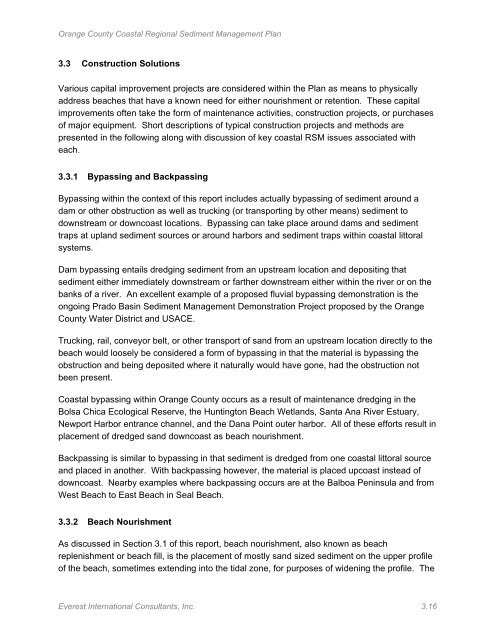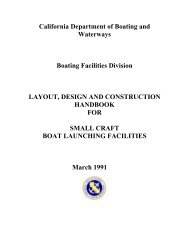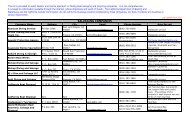EVEREST June, 2013 - California Department of Boating and ...
EVEREST June, 2013 - California Department of Boating and ...
EVEREST June, 2013 - California Department of Boating and ...
Create successful ePaper yourself
Turn your PDF publications into a flip-book with our unique Google optimized e-Paper software.
Orange County Coastal Regional Sediment Management Plan<br />
3.3 Construction Solutions<br />
Various capital improvement projects are considered within the Plan as means to physically<br />
address beaches that have a known need for either nourishment or retention. These capital<br />
improvements <strong>of</strong>ten take the form <strong>of</strong> maintenance activities, construction projects, or purchases<br />
<strong>of</strong> major equipment. Short descriptions <strong>of</strong> typical construction projects <strong>and</strong> methods are<br />
presented in the following along with discussion <strong>of</strong> key coastal RSM issues associated with<br />
each.<br />
3.3.1 Bypassing <strong>and</strong> Backpassing<br />
Bypassing within the context <strong>of</strong> this report includes actually bypassing <strong>of</strong> sediment around a<br />
dam or other obstruction as well as trucking (or transporting by other means) sediment to<br />
downstream or downcoast locations. Bypassing can take place around dams <strong>and</strong> sediment<br />
traps at upl<strong>and</strong> sediment sources or around harbors <strong>and</strong> sediment traps within coastal littoral<br />
systems.<br />
Dam bypassing entails dredging sediment from an upstream location <strong>and</strong> depositing that<br />
sediment either immediately downstream or farther downstream either within the river or on the<br />
banks <strong>of</strong> a river. An excellent example <strong>of</strong> a proposed fluvial bypassing demonstration is the<br />
ongoing Prado Basin Sediment Management Demonstration Project proposed by the Orange<br />
County Water District <strong>and</strong> USACE.<br />
Trucking, rail, conveyor belt, or other transport <strong>of</strong> s<strong>and</strong> from an upstream location directly to the<br />
beach would loosely be considered a form <strong>of</strong> bypassing in that the material is bypassing the<br />
obstruction <strong>and</strong> being deposited where it naturally would have gone, had the obstruction not<br />
been present.<br />
Coastal bypassing within Orange County occurs as a result <strong>of</strong> maintenance dredging in the<br />
Bolsa Chica Ecological Reserve, the Huntington Beach Wetl<strong>and</strong>s, Santa Ana River Estuary,<br />
Newport Harbor entrance channel, <strong>and</strong> the Dana Point outer harbor. All <strong>of</strong> these efforts result in<br />
placement <strong>of</strong> dredged s<strong>and</strong> downcoast as beach nourishment.<br />
Backpassing is similar to bypassing in that sediment is dredged from one coastal littoral source<br />
<strong>and</strong> placed in another. With backpassing however, the material is placed upcoast instead <strong>of</strong><br />
downcoast. Nearby examples where backpassing occurs are at the Balboa Peninsula <strong>and</strong> from<br />
West Beach to East Beach in Seal Beach.<br />
3.3.2 Beach Nourishment<br />
As discussed in Section 3.1 <strong>of</strong> this report, beach nourishment, also known as beach<br />
replenishment or beach fill, is the placement <strong>of</strong> mostly s<strong>and</strong> sized sediment on the upper pr<strong>of</strong>ile<br />
<strong>of</strong> the beach, sometimes extending into the tidal zone, for purposes <strong>of</strong> widening the pr<strong>of</strong>ile. The<br />
Everest International Consultants, Inc. 3.16




